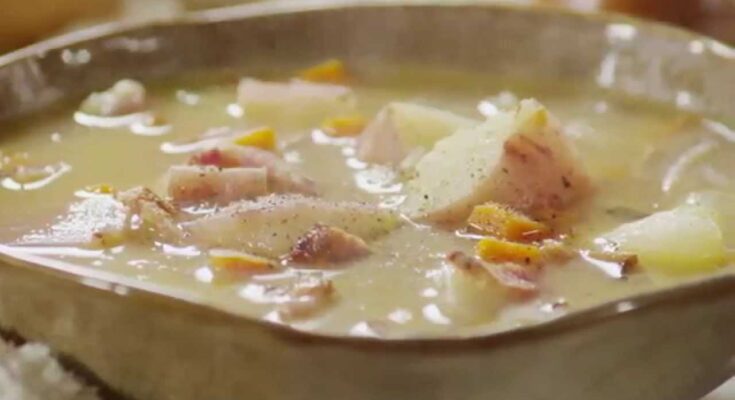Basic Potato Soup Recipe: Let’s face it—there’s nothing quite like a bowl of warm, creamy potato soup on a chilly day. It’s the kind of dish that makes you feel cozy inside, like a big culinary hug. Whether you’re new to cooking or a seasoned home chef looking for a quick, satisfying recipe, this basic potato soup recipe is here to save the day. It’s rich, flavorful, and packed with comfort—all while being incredibly easy to whip up.
You don’t need to be a gourmet chef or have exotic ingredients. All you need are simple pantry staples, a few basic tools, and about 30 to 45 minutes. Plus, it’s customizable! Want it vegetarian? No problem. Prefer a chunky texture over creamy? You got it. Let’s dive into this step-by-step guide that will turn you into a potato soup master.
Ingredients You’ll Need
Main Ingredients
The beauty of this recipe is in its simplicity. These are the essential ingredients:
- 4-5 medium potatoes (Russet or Yukon Gold work best)
- 1 medium onion, chopped
- 2 cloves garlic, minced
- 3 tablespoons butter
- 4 cups chicken or vegetable broth
- 1 cup milk or cream
- Salt and pepper, to taste
These staples form the base of your soup. They bring the body, creaminess, and depth that we all crave in a bowl of potato goodness.
Optional Add-ins for Flavor Boost
Want to elevate your soup a bit more? Try tossing in a few of these optional ingredients:
- Shredded cheddar cheese (for a cheesy twist)
- Chopped celery and carrots (adds more texture and flavor)
- Crumbled bacon (hello, savory goodness)
- Sour cream or Greek yogurt (for an extra creamy finish)
- Fresh herbs like chives, parsley, or thyme
These extras aren’t necessary, but they’re game-changers if you want to kick things up a notch.
Tools and Equipment
Must-Have Kitchen Tools
To keep things smooth and hassle-free, here are the basic tools you’ll want handy:
- Large soup pot or Dutch oven
- Sharp knife and cutting board
- Wooden spoon or spatula
- Measuring cups and spoons
Helpful Tips for Preparation
- Use a nonstick or heavy-bottomed pot to prevent sticking or burning.
- Prep your veggies in advance—it’ll make the cooking process faster and cleaner.
- Have a hand blender or regular blender ready if you prefer a smooth soup texture.
How to Make Basic Potato Soup – Step-by-Step Cooking Instructions
Step 1: Prepping Your Ingredients
Start by peeling and dicing your potatoes into small cubes—this helps them cook faster. Chop the onion and mince the garlic. If you’re using any optional veggies like celery or carrots, get those ready too. The key to smooth cooking is having everything prepped before the heat hits the stove.
Step 2: Sautéing for Flavor
In a large pot, melt the butter over medium heat. Toss in your chopped onions and sauté for 3-5 minutes until they’re soft and translucent. Add the garlic and cook for another minute. This stage builds a solid flavor foundation for the soup. If you’re adding celery or carrots, now’s the time to throw them in.
Step 3: Simmering the Soup
Add the cubed potatoes to the pot and pour in the broth. Bring everything to a boil, then reduce the heat and let it simmer for 15-20 minutes or until the potatoes are tender. You should be able to easily pierce them with a fork.
Step 4: Blending (Optional)
If you like a creamy soup, use an immersion blender directly in the pot to blend the soup until smooth. No immersion blender? Let it cool slightly and carefully transfer to a regular blender in batches. Prefer a chunkier texture? Skip the blending or blend just half the soup and mix it back in.
Step 5: Final Touches and Serving
Stir in the milk or cream, then season with salt and pepper to taste. Simmer for an extra 5 minutes, allowing everything to marry together. Ladle it into bowls, add your favorite toppings like shredded cheese or bacon bits, and serve warm. It’s that easy.
Potato Varieties That Work Best
Choosing the right type of potato can make or break your soup. The best varieties for a creamy potato soup are Russet potatoes and Yukon Gold. Here’s why:
- Russet Potatoes are high in starch, which makes them ideal for creating that classic creamy texture. They break down easily during cooking, helping to naturally thicken the soup without needing flour or cornstarch.
- Yukon Gold Potatoes have a naturally buttery flavor and a smooth texture. They hold their shape a bit more than Russets, which is perfect if you like a mix of creamy and chunky.
Avoid waxy potatoes like red or new potatoes for this soup. They’re better suited for salads or roasting because they don’t break down well and can result in a gluey texture when blended.
Creamy vs. Chunky Texture Tips
The texture of your soup is totally up to your personal preference. Want a velvety, smooth soup? Blend it thoroughly using an immersion blender or food processor. Looking for a more rustic feel? Mash a portion of the potatoes with a fork or potato masher and leave the rest chunky.
Here are a few extra texture tips:
- For ultra-creaminess, stir in a bit of cream cheese or sour cream at the end.
- To keep it hearty, reserve half of the cooked potato cubes before blending, then mix them back into the soup.
- Don’t over-blend if you’re using a blender. It can turn your soup gummy due to the high starch content in potatoes.
Common Mistakes to Avoid
Overcooking the Potatoes
One of the easiest ways to mess up your soup is by overcooking the potatoes. When that happens, they can become mushy and break apart too much, giving your soup a pasty texture. Always check them after 15 minutes of simmering—if a fork goes in easily, they’re done.
Skipping Seasoning Steps
Seasoning isn’t just a final step—it’s a process. Layering your flavors as you cook makes a big difference:
- Salt the onions while sautéing to bring out their sweetness.
- Add pepper and a pinch of herbs when the broth goes in for depth.
- Taste as you go and adjust. You’ll thank yourself later.
Serving Suggestions
What to Serve With Potato Soup
Potato soup is hearty enough to stand on its own, but why not turn your meal into a feast? Here are some delicious pairings:
- Crusty bread or garlic toast – perfect for dunking.
- Grilled cheese sandwiches – the gooeyness complements the soup’s creaminess.
- Side salad – something green and fresh like a Caesar or garden salad balances the richness.
- Roasted veggies – add some color and nutrition to the plate.
Garnish Ideas
The right toppings can take your soup from good to “wow!” Try these:
- Chopped green onions or chives
- Crispy bacon bits
- Grated cheddar or parmesan cheese
- Sour cream or Greek yogurt swirl
- Paprika or a sprinkle of chili flakes for heat
It’s all about adding texture, color, and that finishing burst of flavor.
Storage and Reheating Tips
Best Storage Methods
Made too much? No worries. Potato soup stores well for later. Here’s how to keep it fresh:
- Refrigerator: Store in an airtight container for up to 4 days.
- Freezer: It’s best to freeze soup before adding dairy. Freeze in portions using airtight containers or freezer bags. It’ll last about 1 month.
Reheating Without Losing Texture
When reheating:
- Do it slowly on the stovetop over medium-low heat.
- If frozen, thaw in the fridge overnight first.
- Stir in a little broth or milk if the soup thickened too much while storing.
- Avoid microwaving large batches—it heats unevenly and may ruin the texture.
FAQs About Basic Potato Soup Recipe
1. What are the best potatoes for making potato soup?
Russet or Yukon Gold potatoes are ideal. They have a creamy texture and break down nicely, creating a smooth and hearty soup.
2. Can I make potato soup ahead of time?
Yes, you can! Store it in the refrigerator for up to 3 days. Reheat on the stove over low heat while stirring frequently.
3. Is it possible to freeze potato soup?
Freezing is possible, but the texture may change slightly due to the potatoes. Use an airtight container and thaw overnight in the fridge before reheating.
4. How can I thicken my potato soup?
You can mash some of the cooked potatoes or add a cornstarch slurry (1 tablespoon cornstarch mixed with 2 tablespoons water) to thicken the soup.
5. Can I make this soup vegetarian or vegan?
Absolutely! Use vegetable broth instead of chicken broth and swap out dairy with plant-based milk or cream alternatives.
6. What toppings go well with potato soup?
Try shredded cheese, crumbled bacon, chopped green onions, or sour cream for extra flavor and texture.
7. Can I add other vegetables to the soup?
Yes! Carrots, celery, corn, or spinach make great additions and add more nutrition and flavor.
8. How long does it take to make basic potato soup?
From prep to finish, it usually takes about 30 to 40 minutes.
9. Do I need to peel the potatoes?
Peeling is recommended for a smoother texture, but leaving the skins on adds extra fiber and a rustic feel.
10. What can I serve with potato soup?
Crusty bread, a side salad, or grilled cheese sandwiches are excellent pairings for a comforting meal.
Conclusion
There you have it—a step-by-step, foolproof guide to making the most comforting bowl of basic potato soup. Whether you’re curled up on a rainy day or just want something cozy and simple, this recipe checks all the boxes. It’s versatile, forgiving, and best of all, downright delicious. With just a few ingredients and a bit of love, you’ll be spooning into comfort in no time.
Don’t be afraid to experiment—add your favorite spices, sneak in veggies, or go wild with toppings. Potato soup is your canvas, and your kitchen is the studio. Now grab your spoon and dig into your next favorite homemade dish.



